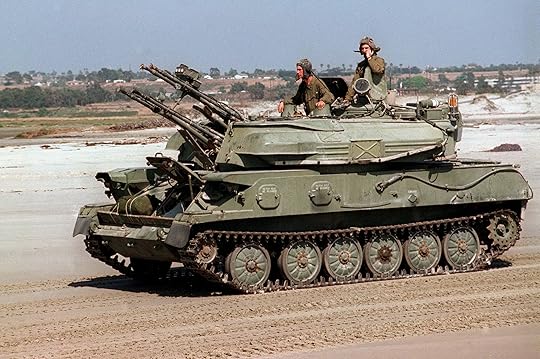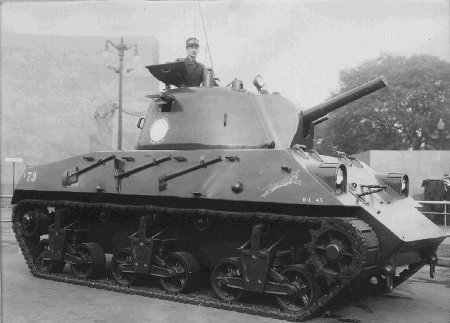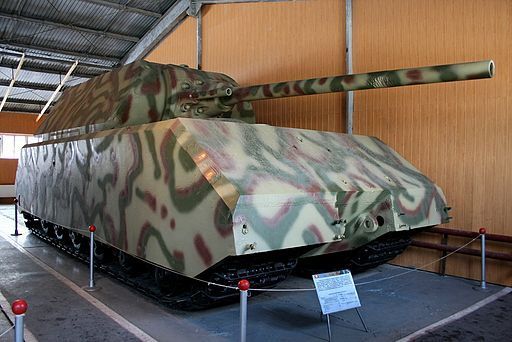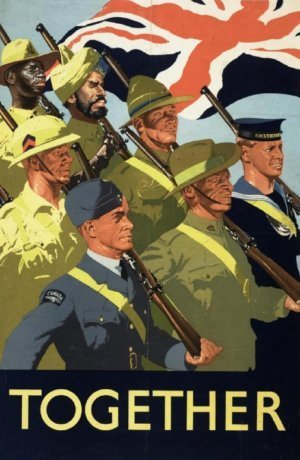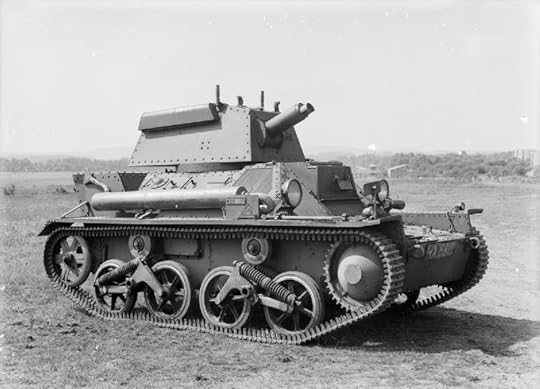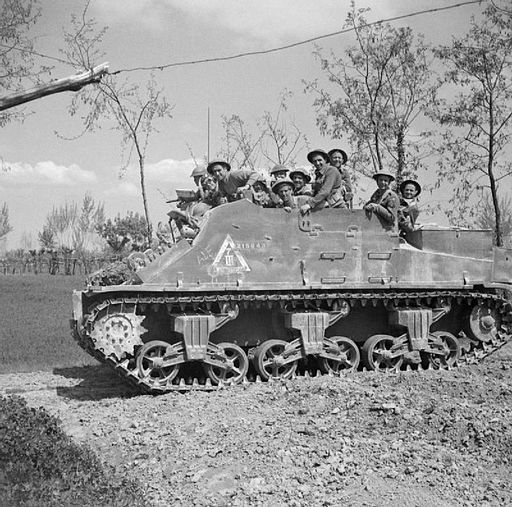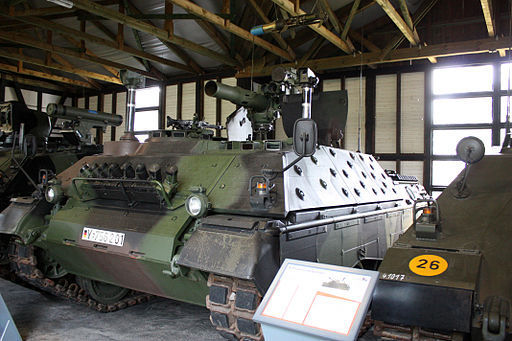Russell Phillips's Blog, page 12
March 29, 2015
Shilka: The ZSU-23-4
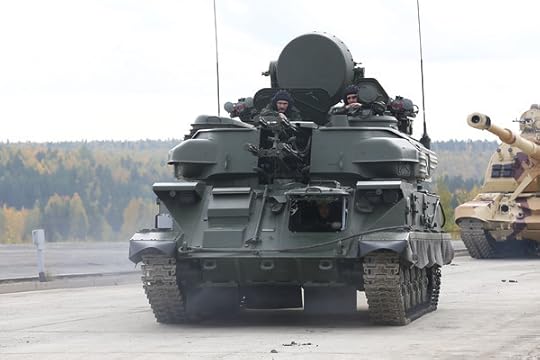
ZSU-23-4 M4, by Aleksey Kitaev [CC BY-SA 3.0]
The ZSU-23-4 entered service in 1966, as a replacement for the much less effective ZSU-57-2. The ZSU-57-2 mounted a pair of 57mm autocannons in an open-topped turret. Lacking a radar, it was a clear-weather system, only able to engage targets that the operator could see. The open-topped turret left the crew vulnerable to artillery fire, and there was no NBC protection.
The new system’s 23mm autocannons are much smaller, leading to a shorter effective range. However, the combination of four barrels instead of two, and the very high rate of fire, greatly increases the probability of a hit. It is fitted with a radar, NBC protection and a fully enclosed turret, thus addressing the major limitations of the earlier vehicle. It also has infra-red night-fighting equipment, but unusually for Soviet AFVs, lacks an amphibious capability. It was the standard self-propelled AA gun throughout the Warsaw Pact, and has been widely exported elsewhere. In 1982, the 2S6 Tunguska started to replace it in Soviet service, but some Shilkas are still in service with the Russian army, and variants are still being produced for export.
The ZSU-23-4 has seen service in the middle east, during the 1973 Yom Kippur War, the Iran-Iraq war in the 1980s, and the 1990 Gulf War. During the Soviet invasion and subsequent occupation of Afghanistan, it was used in a ground support role. The high elevation capability was found to be extremely useful in the mountainous terrain. During the urban fighting in Grozny in 1995, it was used in a ground support role once more, its high elevation useful for reaching tall buildings. Unfortunately, its thin armour made it vulnerable at the short ranges characterised by fighting in a built-up area, issues which led to the development of the BMPT and BMPT-2.
Description
The chassis is based on a modified ASU-85, and it has an enclosed turret holding four water-cooled 2A7 23mm guns (the gun mounting is designated AZP-23). The four autocannons are fed from seperate belts, and so can theoretically each fire different ammunition. In practice, however, the normal load for each belt is three OFZT incendiary fragmentation rounds followed by one BZT armour-piercing tracer round. A Gun Dish radar is fitted for acquisition and tracking, connected to an analogue computer for fire control. The radar can acquire targets at ranges of up to 20km, and track them at ranges up to 18km. Backup optical sights are also fitted, for use in heavy ECM environments.
The crew of four consists of driver, radar operator, gunner, and commander. The driver’s compartment is in the front, with the other three crew members in the large central turret. The engine compartment is at the rear of the vehicle.
The large number of electronic vacuum tubes in the ZSU-23-4 fire-control computer generate a great deal of heat, which caused problems with cooling. In 1966, the ZSU-23-4V entered service, which had changes to the venting covers and removed the heat exchanger from the turret roof. In 1970, the ZSU-23-4V1 was introduced. This had an improved computer, and ventilation system cases at the front of the turret. The ZSU-23-4M, introduced in 1973, had further cooling improvements and enhanced ECCM. From 1977, vehicles were fitted with an improved IFF system and designated ZSU-23-4MZ. This IFF system was retro-fitted to existing ZSU-23-4M systems.
Specifications: ZSU-23-4 Shilka
Crew: 4
Combat weight: 19 tonnes
Length: 6.54m
Width: 3.13m
Height: 3.75m (2.6m with radar down)
Ground clearance: 0.35m
Maximum road speed: 50km/h
Maximum road range: 450km
Gradient: 60%
Vertical obstacle: 1m
Trench: 2.4m
Armament: 4x 23mm 2A7 autocannons (2,000 rounds)
Armour:
Hull: 15mm max
Turret: 9.4mm
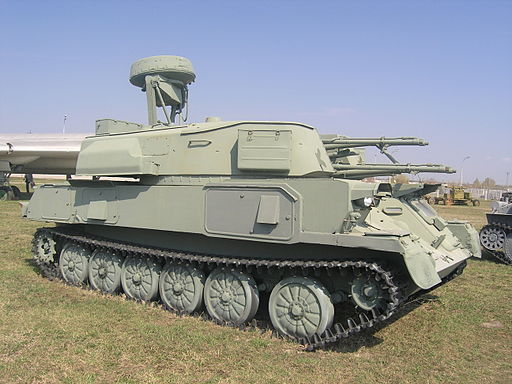
ZSU-23-4 Shilka, by ShinePhantom [CC-BY-SA-3.0], via Wikimedia Commons
Operators
As noted above, the ZSU-23-4 has been widely exported. The full list of operators is as follows:
Afghanistan; Algeria; Angola; Armenia; Azerbaijan; Belarus; Bulgaria; Cameroon; Congo; Cuba; East Germany; Ecuador; Egypt; Ethiopia; Georgia; Guinea-Bissau; Hungary; India; Iran; Iraq; Israel (captured from Arab armies); Jordan; Laos; Lebanon; Libya; Mali; Mongolia; Morocco; Mozambique; Nigeria; North Korea; Peru; Poland; Russia; Sahrawi Arab Democratic Republic; Somalia; Soviet Union; Syria; Turkmenistan; Ukraine; United States (a few acquired for testing); Vietnam; Yemen; Zimbabwe
The post Shilka: The ZSU-23-4 appeared first on Russell Phillips.
Related:
An Ineffective System: The M247 Sergeant York This article has also been published in the Society of...
This interactive quiz has been created as a companion to...
Terminator: The BMPT-2 Tank Support Fighting Vehicle This article has also been published in the Society of...
March 22, 2015
AFV Alphabet: N is for Nahuel
The Nahuel (“Tiger” in Mapuche, an aboriginal langauge) was an Argentinian World War II medium tank, designed in 1943. Although the design was indigenous, it was influenced by the US M4 Sherman. It was armed with a 75mm gun, with co-axial 12.7mm machine gun, and three hull-mounted 7.65mm machine guns. Its armour was up to 80mm thick, and well sloped. It had a top speed of 25mph and a range of 150 miles.
Production stopped after only sixteen vehicles had been built, as in 1946 Argentina bought cheap M4 Shermans from the US and UK, some of which were the British Firefly variant, mounting 17 pounder guns.
The post AFV Alphabet: N is for Nahuel appeared first on Russell Phillips.
Related:
AFV Alphabet: A is for Antonov A-40 Inspired by Tim Gow’s A to Z of Wargaming series...
AFV Alphabet: K is for Kangaroo The Kangaroo was an early armoured personnel carrier, created by...
AFV Alphabet: L is for Light Tank, Marks I to VI Although “light tank” can be a generic term, in this...
March 9, 2015
AFV Alphabet: M is for Maus
The Maus was a World War II German tank design, the result of a May 1942 demand from Hitler for an “indestructable” super-heavy tank. Most German generals considered the project a waste of time and resources, but Hitler had something of an obsession with “wonder weapons” of all types. The original plan was that a prototype, weighing around 100 tons, would be ready by mid 1943. In May 1943, a wooden mockup was ready, and presented to Hitler. By this time, the projected weight had increased to 188 tons. Maus’ tracks were driven by electric motors, which in turn were powered by a large diesel engine coupled to an electrical generator.
A turretless prototype was ready by the end of 1943, and tests were carried out with a mock turret. The extreme weight meant that Maus could not cross bridges, and so an alternative solution had to be developed. Its huge size meant that it could ford relatively deep rivers. For others, a snorkel was developed that allowed it to cross rivers up to 45′ (13m) deep – when snorkelling, a second Maus would provide electrical power through a cable. Maus was armed with a 128mm gun, with a 75mm co-axial gun and a 7.92mm machine gun. Speed was only 8.1mph, with a range of 99 miles on roads, dropping to 39 miles off roads.
At the end of the war, the hull of the second prototype was extensively damaged, but the turret was relatively intact. The Soviets fitted the turret from the second prototype to the hull of the first prototype, and carried out testing on this configuration. Once the testing was complete, it was moved to Kubinka Tank Museum, where it is still on public display.
The post AFV Alphabet: M is for Maus appeared first on Russell Phillips.
Related:
AFV Alphabet: A is for Antonov A-40 Inspired by Tim Gow’s A to Z of Wargaming series...
AFV Alphabet: B is for Bishop During the western desert campaign in the early part of...
AFV Alphabet: C is for Carden Loyd tankette The term “Carden Loyd tankette” actually refers to a series...
Commonwealth Day: Britain Did Not “Stand Alone” in 1940
Today is Commonwealth Day. It seems like an appropriate day to remember that Britain didn’t stand alone in 1940. The Commonwealth, and a few other countries, stood with her. So I’m marking the day by re-posting the following:
Lest we forget … that Britain was not alone
On Remembrance Day 2013 I wrote, “I consider Remembrance Day to be a time to remember everyone that has been harmed by war. Any war, any nationality, civilian, military, whatever.”I still believe that, but it occurred to me recently that there is a commonly-held belief that after the fall of France in 1940, Britain alone opposed Nazi Germany. This is a myth. I don’t know where the “Britain stood alone” idea came from, but it seems likely that it comes from Churchill’s famous “Their Finest Hour” speech. However, to his credit, Churchill recognised that there were countries other than Britain fighting Germany. He didn’t speak of Britain fighting alone, he spoke of “Britain and the British Empire”, and the “British Empire and its Commonwealth”. Even that wasn’t quite true, since countries such as Nepal and Oman, which were neither members of the Commonwealth nor parts of the Empire, had declared war against Germany in 1939.
After France surrendered in 1940, Germany was still at war with Britain. They were also at war with Canada, Australia, New Zealand, South Africa, Bahrain, Nepal, Newfoundland, Oman, and Samoa. None of these countries were covered by the British declaration of war, but had made their own distinct declarations during the first weeks of the war. More countries, including India, were covered by the British declaration of war, since they were part of the British Empire.
These countries made very real contributions to the war effort, even before the entry of other countries such as the USSR and USA. In December 1939, HMNZS Achilles, a New Zealand cruiser, was engaged in the Battle of the River Plate, which led to the sinking of the German pocket battleship Graf Spee. New Zealand pilots fought in the Battle of Britain, and an army division served in North Africa. It’s notable that the only man to win the Victoria Cross and Bar during World War II was a New Zealander. The Royal Canadian Air Force made a major contribution to the Battle of Britain, and her navy fought in the Atlantic. Two Indian infantry divisions fought in North Africa. South Africa provided many pilots during the Battle of Britain, and South Africans fought in North Africa.
When people say that “Britain stood alone” against Nazi Germany in 1940, they’re doing a great disservice to the countries, and the many thousands of men, that fought and died alongside the British. Their contribution and their sacrifice deserves to be remembered.
I will remember them. Will you?
The post Commonwealth Day: Britain Did Not “Stand Alone” in 1940 appeared first on Russell Phillips.
Related:
Unearthed Unveiled On Saturday, my family and I joined 150-200 others at...
For All Our Tomorrows My wife posted the following to Facebook earlier today. I’m...
Britain Did Not “Stand Alone” in 1940 On Remembrance Day last year I wrote, “I consider Remembrance...
March 8, 2015
International Women’s Day: Pink is for Girls, the SAS, Spitfire pilots…
Today is International Women’s Day. I’ve decided to mark it by re-posting one of my earlier blog posts, about the unexpected colour of military badassery, as a friend put it.
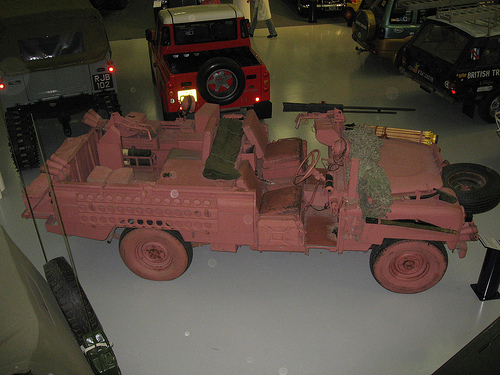
A “Pink Panther” Land Rover – not just for girls
Recently, I mentioned my AFV Alphabet series of posts to my wife and son, and they asked what I was going to write about next. My reply, “The Carden Loyd tankette“, confused my wife. Thinking she hadn’t heard correctly, I repeated the “Carden Loyd”, but apparently it was the “tankette” label that confused her. As she pointed out, the -ette suffix tends to mean feminine as well as diminutive, and has connotations of soft and fluffy. “It sounds like it should be bright pink, possibly with a bow on top”, said my wife. The Carden Loyd tankette is small, but it’s neither soft nor fluffy. It’s a serious military machine.
This got me thinking. I have a six-year old son and a two-year old daughter. My wife and I are constantly frustrated that the whole world seems to think that our daughter should wear bright pink dresses and play with dolls and toy kitchens, while our son should wear blue and play with trains and cars. Both children play with all those things, and if they enjoy them, why shouldn’t they? Why should pink be a girl’s colour and blue a boy’s colour? When she grows up, my daughter will be able to get a job driving a train, a heavy goods vehicle, or an attack helicopter, so why shouldn’t she play with the toy versions of those things? Equally, my son could become a chef, a nurse, or a care worker, so why not play with dolls and toy kitchens?.
The idea that pink is only suitable for girls is ridiculous, and this becomes even more obvious when you look at the use of the colour pink in the military. Back in WWII, some low-altitude photo reconnaissance Spitfires were painted pink. Apparently it provides effective camouflage against cloud, and given the hazardous nature of the mission, anything that helped the pilot survive was a good thing. Until the 1980s, when the SAS operated in the desert, they painted their Land Rovers pink (they’re still known as “Pink Panthers”, even though the colour scheme has changed), because it was considered an effective camouflage colour. These same Land Rovers bristled with machine guns. Whatever the colour, Pink Panther Land Rovers are neither soft nor fluffy.
Photo: Army pink land rover by Paul brown, via Flickr (CC-BY-SA)
The post International Women’s Day: Pink is for Girls, the SAS, Spitfire pilots… appeared first on Russell Phillips.
Related:
Pink is for Girls (and the SAS, Spitfire pilots…) Recently, I mentioned my AFV Alphabet series of posts to...
Unearthed Unveiled On Saturday, my family and I joined 150-200 others at...
Britain Did Not “Stand Alone” in 1940 On Remembrance Day last year I wrote, “I consider Remembrance...
February 23, 2015
AFV Alphabet: L is for Light Tank, Marks I to VI
Although “light tank” can be a generic term, in this case it refers to the series of light tanks (Marks I to VI) produced by Vickers for the British Army in the inter-war period. I’m not including the Mark VII Tetrarch or Mark VIII Harry Hopkins, as they were significantly different from the earlier versions, and would warrant separate posts.
The Mark I Light Tank was developed from a design by Carden-Loyd, by then part of Vickers-Armstrong. Only about 9 or 10 were built, but experience gained was used in development of the Mark II, and then the Mark III and Mark IV. These first four versions were armed with a single 0.303″ Vickers machine gun, and had around 14mm of armour. The Mark V added a 0.50″ Vickers machine gun, giving the tank some measure of capability against other light tanks, and increased the crew from two to three (commander, gunner, and driver). The additional crewman made this version significantly more effective, since the commander was freed from having to operate the gun and radio.
The Mark VI was the only version produced in significant numbers, with production running to 1,682 vehicles. The Mark VIA and Mark VIB variants had the same armament as the Mark V, but the Mark VIC increased armament again to one 15mm Besa machine gun and one 7.92mm Besa machine gun.
All models saw were widely used for imperial policing duties in the British Empire, particularly India. When war broke out in 1939, more than 80% of the British Army’s tanks were Mark VI Light Tanks. Most tanks used by the BEF during the Battle of France in 1940 were Mark VI Light Tanks, and they made up more than half the tank strength during the battles against the Italians in North Africa during 1940. Mark VI Light Tanks also fought in the battles of Greece and Crete.
The post AFV Alphabet: L is for Light Tank, Marks I to VI appeared first on Russell Phillips.
Related:
AFV Alphabet: B is for Bishop During the western desert campaign in the early part of...
AFV Alphabet: C is for Carden Loyd tankette The term “Carden Loyd tankette” actually refers to a series...
AFV Alphabet: D is for Deerhound “T17-Deerhound-armored-car-2“. Licensed under Public domain via Wikimedia Commons. The T17...
February 19, 2015
Help us to help Chernobyl’s children

All this hair is to go! Give generously and make it worthwhile.
Almost thirty years ago, on 26th April 1986, there was an explosion and fire at the Chernobyl nuclear power plant in the USSR. Thirty-one people died during the accident. Today, the local children still suffer. As well as the obvious effects from lingering radiation, many are left orphaned when their parents succumb to the same effects.
My seven-year old son and I both have long hair. We have decided to cut off our pony tails to raise money for Chernobyl Children’s Project (UK), who help the children that are still suffering from the after-effects of the Chernobyl disaster. The hair itself won’t be wasted – it’ll be sent to The Little Princess Trust, so that they can make wigs for children that have gone bald due to chemotherapy treatment.

Scan to donate £5
We’ll be cutting our pony tails off (and getting our hair cut very short – probably a grade 2) on the 19th of April. In the meantime, please donate in one of the following ways:If you’re in the UK, you can text CCUK54 and an amount (eg “CCUK54 £5″) to 70070.
Scan the QR code to the right to give £5 by text.
Go to our Just Giving page at www.justgiving.com/DougDadHaircut.
We’ve set ourselves a target of £500. Anything you can give will be gratefully received, both by us and by the children of Belarus.
Tweetables
Help the children still suffering from the Chernobyl disaster – Click to tweet
Remember Chernobyl? The kids who live there still suffer. Please help my son and I to help them – Click to tweet
The post Help us to help Chernobyl’s children appeared first on Russell Phillips.
February 9, 2015
AFV Alphabet: K is for Kangaroo
The Kangaroo was an early armoured personnel carrier, created by simply removing the turret from a tank or (as in the photograph above), by removing the main armament from a self-propelled gun. It was devised by the Canadians as a way to reduce infantry losses. The first examples were based on M7 Priest self-propelled guns, converted at a field workshop code-named Kangaroo (which is where the name came from). As well as removing the main armament, the Priests had their front aperture covered over.
Most Kangaroos were based on Priests (these examples were sometimes referred to as “defrocked Priests”) and Canadian Ram tanks, although Sherman and Churchill tanks were also used. All variants were known as Kangaroos, with the base vehicle name as a prefix (Sherman Kangaroo, Ram Kangaroo, Churchill Kangaroo, etc). Despite being created as a simple and quick solution to a problem, the Kangaroo was a great success, and many more conversions were carried out. The success of the Kangaroo led directly to post-war APCs such as the American M113, British FV432, and Soviet BTR-50.
The post AFV Alphabet: K is for Kangaroo appeared first on Russell Phillips.
Related:
AFV Alphabet: A is for Antonov A-40 Inspired by Tim Gow’s A to Z of Wargaming series...
AFV Alphabet: B is for Bishop During the western desert campaign in the early part of...
AFV Alphabet: C is for Carden Loyd tankette The term “Carden Loyd tankette” actually refers to a series...
January 26, 2015
AFV Alphabet: J is for Jaguar
The Jaguar 1 and Jaguar 2 are West German ATGM-armed tank destroyers, also known as Raketenjagdpanzer 3 and Raketenjagdpanzer 4, respectively. They were conversions of earlier tank destroyers. The Jaguar 1 was converted from the Raketenjagdpanzer 2, with the SS.11 ATGM replaced by a HOT ATGM. The Jaguar 2 was converted from the Kanonenjagdpanzer. The gun was removed, and a TOW AGTM launcher was fitted to the roof. Both vehicles had upgraded armour, a 7.62mm MG3 on an AA mounting and smoke dischargers. The Jaguar 1 also had a bow-mounted MG3.
Even with the additional armour, neither vehicle was heavily armoured, and so rely primarily for defence on speed and their low profile. They have an excellent top speed of 70 km/h (44 mph), and an operational range of around 400 km (250 miles). Both vehicles have a crew of four, all of whom sit in a fighting compartment to the front of the vehicle.
The post AFV Alphabet: J is for Jaguar appeared first on Russell Phillips.
Related:
AFV Alphabet: F is for Fox Theoretically, there are many choices for “F”, since the British...
AFV Alphabet: G is for Gvozdika The 2S1 Gvozdika self-propelled 122mm howitzer was accepted for service...
AFV Alphabet: H is for Hornet The FV1620 Humber Hornet was an early ATGM carrier, which...
January 19, 2015
SMS Deutschland, the Civilian U-Boat
The idea of merchant submarines, a variation on standard merchant ships, has been suggested on multiple occasions, but has only been put into practice once, during WWI. In 1916 a class of seven u-boats was built by a private shipping company. These new u-boats were large, displacing over 2,200 tons, and with a wide beam to facilitate loading. They had no torpedo tubes or other armament, being civilian vessels operated by a civilian company, the North German Lloyd Line.
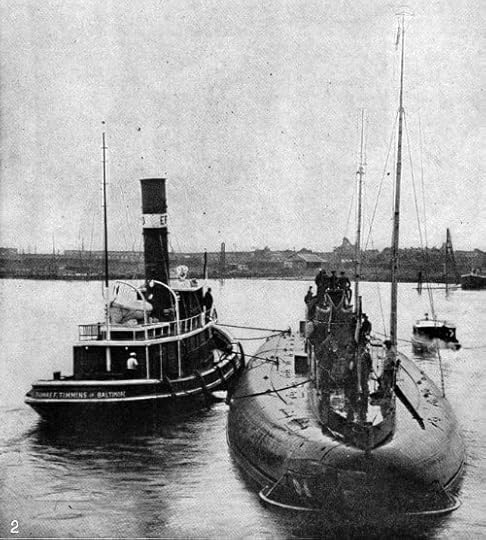
SMS Deutschland. Note the very wide berth
Although they were large by u-boat standards, their cargo capacity of around 700 tons was relatively small by surface ship standards. Their ability to submerge to avoid detection, however, was a significant advantage for a country that was under an efficient naval blockade. The blockade, put in place by the Entente powers, was severely hampering German trade and making it difficult for German companies to acquire raw materials. Of the seven merchant submarines built, only two were used in their intended role, and of those two, SMS Bremen sank on her maiden voyage. SMS Deutschland made two successful round voyages to the United States.
Maiden Voyage
SMS Deutschland set off on her maiden voyage on 23 June 1916, with a crew of four officers and twenty-five men, under the command of Paul König. She carried 750 tons of high-value cargo (patented dyes, medicines and gemstones). She passed through the English Channel without detection, and arrived at Baltimore on 9 July 1916.
Her arrival at Baltimore was noted by all belligerent nations, and great concern on the part of the Allies. König immediately made an announcement, in which he stated that “Our trip passing Dover across the ocean was an uneventful one.” and “Needless to say that we are quite unarmed and only a peaceful merchantman.” The crewmen were treated as celebrities during their time in Baltimore, due to the novel and remarkable voyage that they had undertaken. The naval architect Simon Lake visited the submarine, and made arrangements to build cargo submarines in the US, though this project never came to fruition.
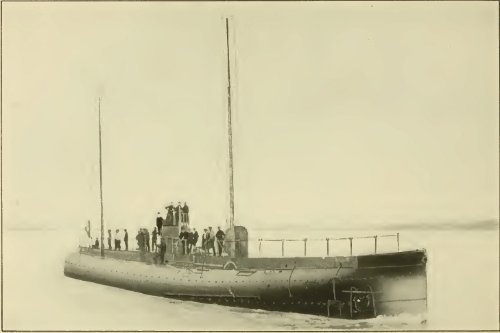
SMS Deutschland in Chesapeake Bay, approaching Baltimore
The Allies reacted quickly, sending a note of protest to the US Government. The United States, like other neutral countries, allowed merchant vessels from all belligerent nations to trade freely. However, the Allies’ note suggested that submarines should not be covered by such rules because they couldn’t be stopped and examined to determine which country they originated from, and whether or not they were actually combatant. The note further stated that there was a “capacity for harm inherent in the nature of such vessels“. The Allies wanted neutral countries to detain any submarine from warring nations that entered one of their ports. They went so far as to make a veiled threat, stating that neutral submarines would be in “grave danger“, should they navigate regions frequented by belligerent submarines.
Germany was putting a great deal of diplomatic pressure on the United States, claiming that, despite claiming to be neutral, it generally adopted a pro-Allied posture. On the 31 August 1916, the US Government sent a reply to the Allied nations, which took the German side. The strongly worded reply stated that the Government of the United States did not see any reason why submarines (either war or merchant) should not be covered by the existing rules of international law. The reply also specifically rebuffed the claim that neutral submarines may be in “grave danger”, stating that the US Government “holds it to be the duty of belligerent powers to distinguish between submarines of neutral and belligerent nationality“.
By this time, the Deutschland was back in Germany, having departed Baltimore on 2 August and arrived back at Bremerhaven on 24 August. She carried 341 tons of nickel, 93 tons of tin, and 348 tons of crude rubber, the majority of the rubber being stored outside the pressure hull. Of the 8,450 nautical miles that she had travelled, 190 nautical miles were submerged.
SMS Deutschland set off for its second journey to the United States in November 1916, this time to New London, Connecticut, carrying gems, securities and medicinal products. She set off for the return voyage on 16 November, but accidentally rammed a tugboat. The tug sank with a loss of five lives, and the Deutschland‘s bows were damaged. After repairs, she left on 21 November, and returned home safely. A book entitled Voyage of the Deutschland, the First Merchant Submarine, with König credited as author (though it was probably ghost-written), was published in late 1916 and heavily publicised, in an attempt to sway public opinion in both Germany and the United States.
Military Service: U155
A third voyage was planned for January 1917, but was cancelled due to worsening relations between Germany and the United States. In February, it was taken into the German High Sea Fleet and converted to a u-cruiser, number U155. She was fitted with two 15cm guns, two torpedo tubes, and could carry about thirty torpedoes.

U155 in London, 1918
During 1917, she made a 105-day long cruise under the command of Karl Meusel. She sank 19 merchant ships and attacked 19 armed merchantmen, sinking nine of them.
In August 1918, she sailed again, under the command of Ferdinand Studt, with orders to cruise off the US coast, laying mines and cutting telegraph lines. This cruise was much less successful than the 1917 cruise, laying her mines in the wrong place and failing to locate a telegraph line. She sank three merchantmen, but was damaged on 13 September, rendering her temporarily unable to dive. She returned to Germany on 12 November 1918. She was taken to Britain, where she was put on display before being sold for scrap in 1921.
Specifications: SMS Deutschland
Displacement: 2,272 tons
Length: 65 m (213 ft)
Beam: 8.9 m (29 ft)
Draught: 5.3 m (17 ft)
Propulsion: 800 hp
Speed: 15 knots surfaced, 7 knots submerged
Range: 10,977 nautical miles
Capacity: 700 tons
Complement: 4 officers, 25 men
Armament (U155):
2x bow torpedo tubes (30 torpedoes)
2x 150mm deck guns
This article was originally published in the Society of Twentieth Century Wargamers Journal.
The post SMS Deutschland, the Civilian U-Boat appeared first on Russell Phillips.
Related:
Szent István: Hungary’s Battleship As a land-locked country with no coastline, it may come...
The Sinking of SMS Wien On the 10th of December 1917, the Austro-Hungarian Monarch class...
The Otranto Barrage The Otranto Barrage was a naval blockade of the Otranto...

